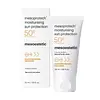What's inside
What's inside
 Key Ingredients
Key Ingredients

 Benefits
Benefits

 Concerns
Concerns

 Ingredients Side-by-side
Ingredients Side-by-side

Water
Skin ConditioningOctocrylene
UV AbsorberEthylhexyl Methoxycinnamate
UV AbsorberBenzophenone-3
UV AbsorberCyclopentasiloxane
EmollientGlyceryl Stearate
EmollientDimethicone
EmollientZinc Oxide
Cosmetic ColorantButyl Methoxydibenzoylmethane
UV AbsorberStearyl Alcohol
EmollientUrea
BufferingCeteareth-25
CleansingCetearyl Alcohol
EmollientStearic Acid
CleansingTitanium Dioxide
Cosmetic ColorantGlycerin
HumectantCeteareth-20
CleansingCeteareth-12
EmulsifyingTetrahydrodiferuloylmethane
AntioxidantPhenoxyethanol
PreservativePanthenol
Skin ConditioningEthylhexylglycerin
Skin ConditioningTocopheryl Acetate
AntioxidantCetyl Palmitate
EmollientParfum
MaskingLactic Acid
BufferingTetrasodium EDTA
Water, Octocrylene, Ethylhexyl Methoxycinnamate, Benzophenone-3, Cyclopentasiloxane, Glyceryl Stearate, Dimethicone, Zinc Oxide, Butyl Methoxydibenzoylmethane, Stearyl Alcohol, Urea, Ceteareth-25, Cetearyl Alcohol, Stearic Acid, Titanium Dioxide, Glycerin, Ceteareth-20, Ceteareth-12, Tetrahydrodiferuloylmethane, Phenoxyethanol, Panthenol, Ethylhexylglycerin, Tocopheryl Acetate, Cetyl Palmitate, Parfum, Lactic Acid, Tetrasodium EDTA
Ingredients Explained
These ingredients are found in both products.
Ingredients higher up in an ingredient list are typically present in a larger amount.
Urea is also called carbamide and is the diamide of carbonic acid. In cosmetics, urea is used to hydrate the skin. It also provides exfoliation in higher concentrations.
As a humectant, urea helps draw moisture from the air and from deep within the skin. This helps hydrate your skin. Studies show urea is an effective moisturizer for dry skin conditions. 40% urea is typical in medications for treating eczema and other skin conditions.
Urea has the strongest exfoliation effect in concentrations higher than 10%. It is a keratolytic agent, meaning it breaks down the keratin protein in the top layer of skin. This helps remove dead skin cells and flaking skin.
In medicine, urea has been shown to help increase the potency of other ingredients, such as fungal treatments.
Humans and animals use urea to metabolize nitrogen-containing compounds. Urea is highly soluble in water. Once dissolved, it is neither acidic nor alkaline.
Learn more about Urea